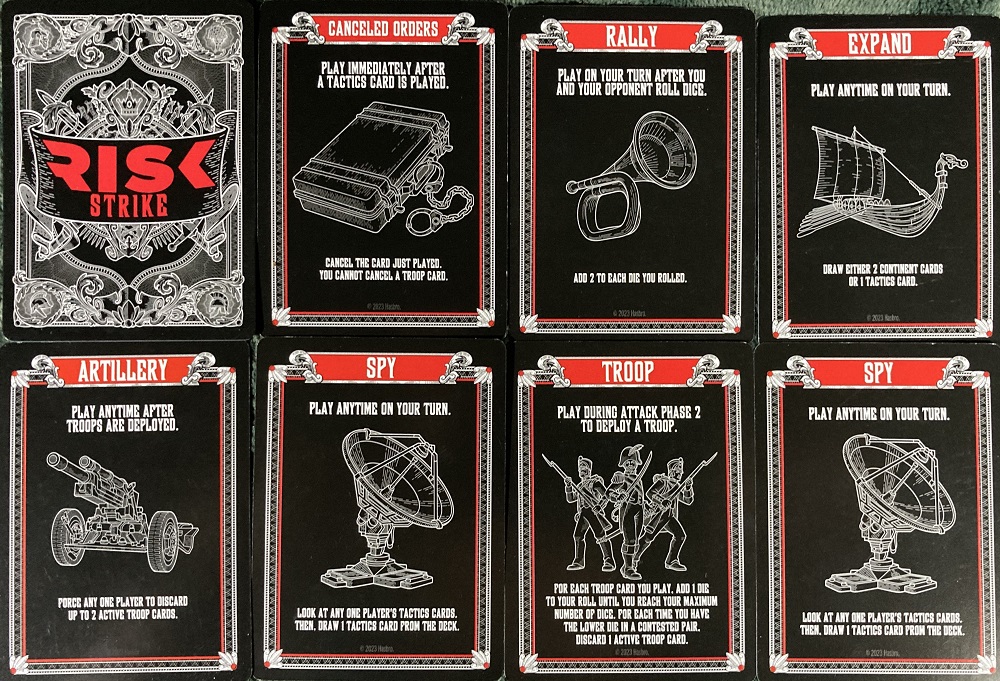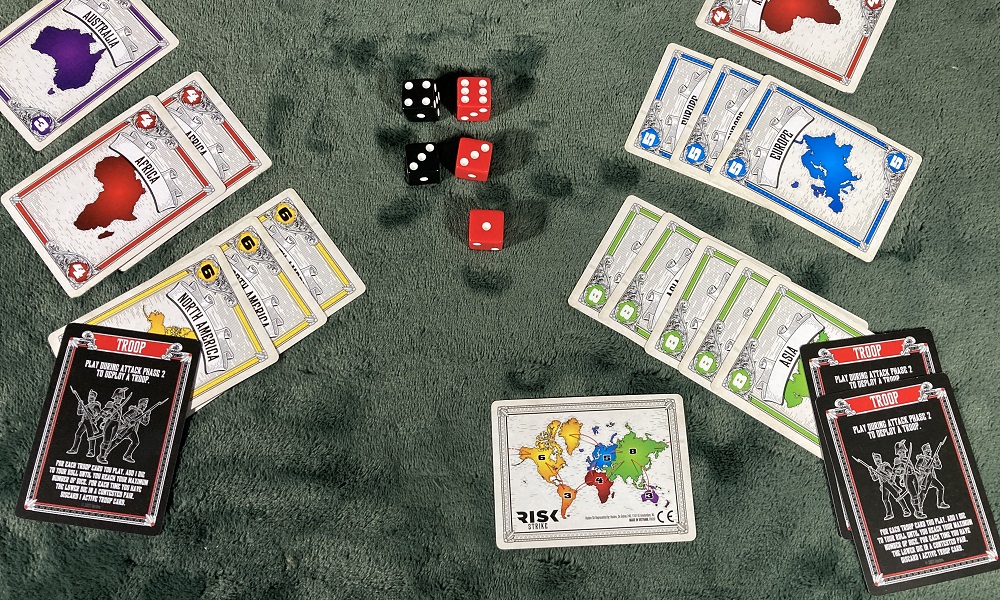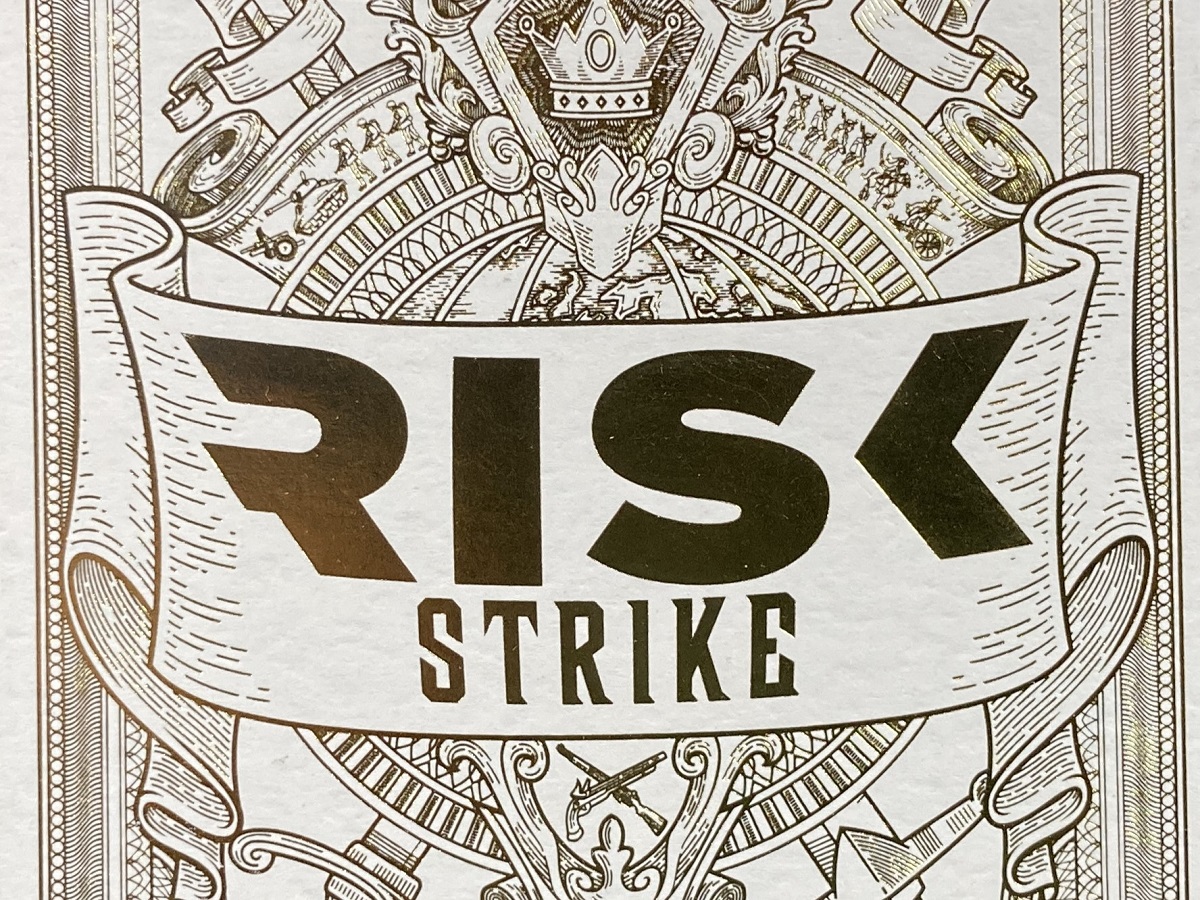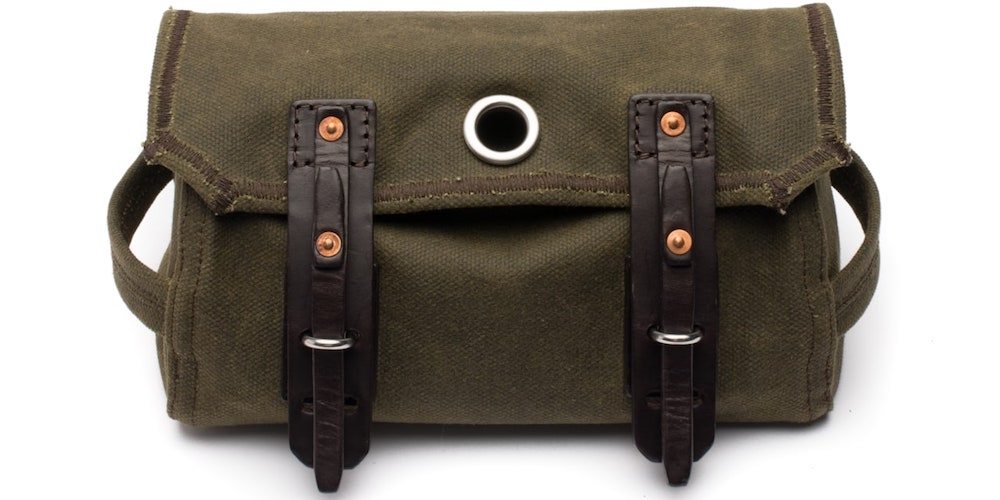I was first introduced to the board game Risk when I was only 12 years old. Since that time I have played it in many variations and themes. However, these games took up a lot of space on a table and at least a couple hours to play. With all of the small pieces, it was not a game I could easily take with me for camping or while travelling. Now a new game of world domination has arrived to solve the problems of time and space, Risk Strike.
What Is Risk Strike?
Risk Strike is a combination dice rolling card game for 2-5 players, ages 10 and up, and takes about 20 minutes to play. This game is based on the original board game and players try to dominate continents while preventing their opponents from doing the same. It’s currently available from your local game store as well as online retailers such as Amazon. Risk Strike sells for $21.99 and was designed by George Feledichuk, David “Duvey” Rudow, and Leo Taylor and published by Avalon Hill and Hasbro.
Risk Strike Components
Here is what you get in the box:
- 42 Continent cards
- 40 Tactics cards
- 6 Domination coins
- 5 Dice
- 5 Reference cards
- 1 Rule book

There are six different continent cards. Each has the name and image of one of the six continents in the game as well as a number in the corner which is the domination number. Players collect and capture continue cards and once they have a matching stack equal to the domination number, they can collect a domination coin.

There are eight types of tactics cards that can be played at different times. Troop cards can be played at the start of a battle to deploy troops for either attacking or defending. Some are played during your turn while others are played after dice are rolled during a battle to modify the results before the battle is resolved. Some tactics cards can turn a sure victory into a quick defeat.

Domination coins are collected by conquering continents and act as victory points. A player needs to collect any two domination coins to win the game. Domination coins can be taken by other players as well.

Each player receives a two-sided reference card. On one side is a map of the six continents listing their domination numbers as well as how they are linked to other continents. The flip side lists the turn order as well as the phases for attacking.
How to Play Risk Strike
The Goal
The goal of the game is to collect two domination coins before the other players.
Setup
Risk Strike is quick to setup. First shuffle the white continent cards and place the deck face down in the middle of the play area. Each player then draws three continent cards and places them face up in front of them. Now shuffle the black tactics cards and deal three to each player to form their hand. Then place the remaining tactics cards face down on the table with enough space between it and the continent cards for surrendered continent cards. Give each player a reference card, and then players each roll a die to determine who goes first. The highest roll is the winner. All of the other players draw an additional tactics card and in a 2-player game, the player going second also draws an additional continent card and places it in front of them.

Gameplay
The gameplay in Risk Strike is divided into turns. During each player’s turn, they first draw any two cards. They can draw two continent cards, two tactics cards, or one of each type of card. once there are continent cards in the surrendered pile, players may draw these as one or both of their cards for the turn. Next the player can choose to either attack or to pass. If they pass, the player draws an additional tactics card and ends their turn and the player to the left begins their turn. Attaching is divided into three phases. Let’s take a look at each phase.
Declare Battle
First the player declares from which continue they are attacking. They can only attack from continents for which you have continent cards. They then choose one other player as the target and declare which continent of theirs they are attacking. The attacking player can attack the same continent from which they are attacking or one connected to that continent. The reference card shows how continents are connected.
Deploy Troops
The attacking player can deploy troops by playing troop cards next to the continent from which they are attacking. The defending player can then play troop cards to their cards of the continent they are defending. Finally other players can play troop cards on top of either the attacker’s or defender’s troop cards to help support them.
Roll and Resolve
The attacker counts their attacking continent and active troop cards and can then roll that many dice up to a maximum of three. The defender counts their defending continent and troop cards and rolls that many dice up to a maximum of two. Each player lines up their dice from highest to lowest and compare them to their opponent’s dice: highest against highest and second highest against second highest. The higher die in each pairing is the winner and ties go to the defender. The player with the lowest die in each pairing must discard an active troop card. If they do not have any remaining troop cards, the defender must give a continent card to the attacker. However, if the attacker loses and has no more active troop cards, they must surrender a continent card face up to the surrendered continent pile between the two card decks. It is possible for each player to win one dice pairing and lose the second pairing.
If there are no defending continent cards remaining, the battle is over and the active player ends their turn. However, if there are still defending and attacking continent cards, the attacker may choose to continue the battle by rolling and resolving dice. Be sure to check the number of cards remaining and roll the corresponding number of dice.

Dominating
Once a player has claimed a number of continent cards of the same type equal to the domination number located in the top corner of the card, they may take that continent’s domination coin. If another player has that coin, they take it from that player. A player holds onto a domination coin, even if they lose continent cards of that type and have fewer than the required number. You only lose a coin when another player has enough continent cards of that type to reach the domination number.
Game End
The game ends when a player collects two domination coins and is declared the winner.

Why You Should Play Risk Strike
The gameplay in Risk Strike is fairly simple. Just draw two cards and then either attack or pass. Passing lets you take an extra tactics card, so at the start, that is what players tend to do. I was surprised at just how fun and engaging this game really is. The first game I played was with high school students during a tabletop game club meeting. We played with five players and even while explaining how to play, our game lasted 22 minutes. The attacks go pretty quickly since a few rolls of the die will usually resolve a battle. The tactics cards add a lot to the game. While a lot of them are troop cards which you need to not only attack but also to help defend your territories, the other tactics cards can have some important and even spoiling effects. Sabotage ends the battle immediately and sends troops back to their players hands–and also ends the active player’s turn. Bombard and Rally allow you to change the values of dice after they are rolled. Expand lets you draw two continent or one tactics cards which can be a great way to add some territory since this is in addition to the two cards you drew at the start of the turn. During our games, Artillery was quite effective since it forces a player to discard up to 2 troop cards. This was often used to stop an attack since most attackers only attacked with two troop cards.

While there was a lot of action going on with a 5-player game, both 3- and 4-player games also had a similar feel. A 2-player game felt more like a duel, which it is, since you are focusing on just one player and there are less options for going after territory as when there are more players. However, no matter how many players, Risk Strike is a fast-paced game that keeps everyone on their toes. This is especially important since you need to watch what tactics cards other players are playing so you know what to expect either when you are attacked or are attacking. So many carefully planned attacks can be foiled or changed with a well-played tactics card. The game also has a balancing effect. If one player starts getting close to winning, other players will throw down troop cards to help the defender and prevent the attacker from getting a second domination coin.
I actually enjoyed Risk Strike more than I thought I would. I have not played the boardgame Risk in years, maybe even a decade. It can take a lot of time to setup and play and a lot of it relies on dice rolling. However, Risk Strike is my new game I will go to when I want get a quick fix of Risk. I like that it is quick to setup, teach, and play. Plus, since the games are usually over in about 20 minutes, a loss does not seem as devastating as losing after two hours. Once one game is over, shuffle the cards and you are ready to go again. Limiting players to only one attack per turn also keeps the game moving. The small size of the box and needing just six domination coins and five dice in addition to the cards to play make this a great game to take with you for while camping or travelling. Anywhere you can play a card game, you can play Risk Strike. If you are looking for a new way to play Risk, or wanting to relive past glories of the board game without the time and space, then I recommend adding Risk Strike to your collection. It also makes a great gift for new as well as experienced players.
For more information, visit the Hasbro Gaming Store on Amazon.
Click here to see all our tabletop game reviews.
![]() To subscribe to GeekDad’s tabletop gaming coverage, please copy this link and add it to your RSS reader.
To subscribe to GeekDad’s tabletop gaming coverage, please copy this link and add it to your RSS reader.
Disclosure: GeekDad received a copy of this game for review purposes.






